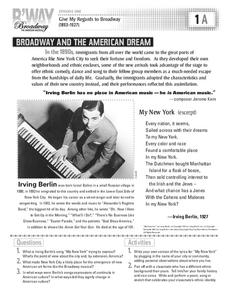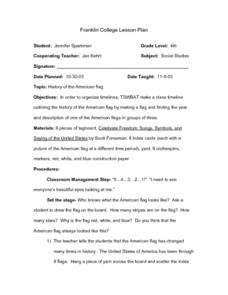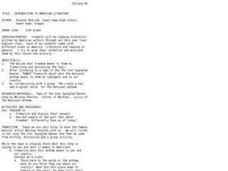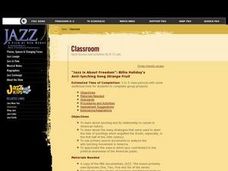Annenberg Foundation
Slavery and Freedom
How do nineteenth-century texts by African American and Native American writers contribute to the country's ideals of freedom and individuality? Learners explore the topic by watching and discussing a video, reading biographies, writing...
K12 Reader
Song of Freedom: Go Down, Moses
African American spirituals served as more than songs of religious praise during the years of slavery. "Go Down, Moses" is featured on a worksheet that asks readers to respond to a series of short-answer prompts about the spiritual.
Carolina K-12
Group Project: Freedom Parade
Parades are a great way to celebrate. Get young historians into the festivities by asking them to create an informational float for a Freedom Parade. Picking a topic from the provided list or suggesting one of their own, class members...
PBS
Broadway and The American Dream
Considering a unit study of American Musical Theatre? What better way to start than at the very beginning. Eight pairs of cards provide class members with background information about the genre from 1893 through 2004. The cards are...
National Park Service
Lesson 1: Journaling with Songs of Freedom
There's more to music than a memorable tune. The songs of those who were enslaved reveal the harsh realities of their lives. Using both songs and slave narratives, historians uncover this hidden history. The lesson incorporates a variety...
Charlesbridge
Under the Freedom Tree: A Readers Theater
Susan VanHecke's Under the Freedom Tree is transformed into a 12-part readers theatre script appropriate for a performance by upper-elementary classes.
Curated OER
The Statue of Liberty: The Meaning and Use of a National Symbol
Engage your class in a series of activities, each related to the use or analysis of symbols used to convey patriotic or national concepts. They identify different national symbols and explain their meanings, discussing the importance of...
National Park Service
Lesson 5: Coded Spirituals, Metaphor in African Spirituals
If a picture is worth a thousand words, song lyrics also can communicate many meanings. Using the lyrics of spirituals, young historians analyze them for coded messages about freedom. Resources include a chart to help individuals track...
Curated OER
Freedom, Power and the People
Students analyze how social change has affected artistic expression and popular culture. the explain the influence of media on contemporary American culture.
Library of Virginia
An Overview of American Slavery
The final lesson in a unit study of American slavery asks young historians to synthesize what they have learned about how slavery in America changed over time. Revisiting the many documents they have examined, they consider the economic,...
Curated OER
We Are The Freedom Riders
Students consider the role of the Freedom Riders. In this American Civil Rights lesson, students watch videos, listen to lectures, and conduct research regarding the participants in the Freedom Ride protest. Several weblinks, worksheets,...
Curated OER
History Of The American Flag
Fourth graders investigate the concept of the American Flag. They conduct research using a variety of resources and answer questions to create the context for the information search. Then students use the information to have class...
National Constitution Center
Born in the U.S.A: Music as Political Protest
Though often used in shows of patriotism, Bruce Springsteen's 1985 song "Born in the U.S.A." is critical of America's role in the Vietnam war and its treatment of American veterans. High schoolers analyze the song's lyrics in an activity...
Curated OER
Introduction to American Literature
High schoolers discuss the topic of freedom and what the National Anthem means to them and to our country. They create a new and original verse for the National Anthem.
Curated OER
What Does This Song Really Say?
Students investigate communication by analyzing lyrics from a song. In this music arts lesson, students discuss slavery, the Underground Railroad and African American traditions while listening to a song called "This Train." Students...
Curated OER
Understanding Freedom: Catching "The Spirit of '76"
Sixth graders complete activities about colonial history through an examination of art from the American Revolution period. In this history and art lesson plan, 6th graders define an iconic image, sing the song 'Yankee Doodle,' and...
National Park Service
Lesson 2: Hope
There's hope in music. Pupils discover what gave enslaved people hope by examining lyrics and music during their time of bondage. A series of prompts helps individuals investigate songs of enslaved people. The cumulative assignment...
National Park Service
Lesson 4: Escape
Some enslaved people decided to run for their liberation. Using lyrics of songs they sang, young historians look at these anthems of freedom. An assessment asks them to write the story of escape from the perspective of an enslaved...
Music Publishers Association of the United States
I Made It. I Own It. Please Don't Steal It.
Explore the world of copyright law with a variety of activities to instill the importance of respecting creative property. Scholars watch an animated tale then take part in a grand conversation detailing the video's main idea, details,...
Alabama Learning Exchange
J. Alfred Hyperbolizes
Mermaids will sing to your class members as they engage in an activity related to T.S. Eliot's famous dramatic interior monologue. After engaging in a socratic seminar about literary devices in the poem, individuals choose one...
Curated OER
Appreciating Our American Heritage
Students learn about the Chinese culture via literature. They read the poetry of Cathy Song, considering national pride as Americans and Chinese.
Curated OER
Call and Response Singing
Learners investigate call and response singing. In this fine arts and U.S. history lesson, students listen to several call and response songs that were sung by African-American slaves during the period before the Civil War. ...
National Endowment for the Humanities
From Courage to Freedom: The Reality behind the Song
Young scholars study how Frederick Douglass uses language to describe a realistic picture of slavery in his writings which are primary source documents. They examine his use of word choice, imagery, irony, and rhetorical appeals and use...
Curated OER
"Jazz is About Freedom": Billie Holiday's Anti-lynching Song Strange Fruit
Working in small teams, learners analyze a variety of primary source materials related to lynching (news articles, letters written to or written by prominent Americans, pamphlets, broadsides, etc.) in order to assess the effectiveness of...

























